6 The Modern Synthesis
Tori M Saneda

The Modern Synthesis
The Modern Synthesis incorporates data from multiple scientific disciplines: biology, the natural sciences, genetics, paleontology, and paleoanthropology. While the basis for evolutionary theory was established by the beginning of the twentieth-century, debate continued as to whether natural selection or mutation was more important in evolution. In the 1930s, these two points of views came together to form the basis of the modern synthesis. Fisher, Haldane, and Wright developed mathematical models that became the foundation of population genetics, a field that studies the “changes in gene frequencies and the effects of those changes on adaptation and evolution” (Larsen 2022: G16). However, it was Theodosius Dobzhansky that married theoretical modeling and empirical research in his seminal work, Genetics and the Origin of Species (1937) and signals the start of the Modern Synthesis (Artmann 2006). Biologist Ernst Mayr was another major contributor to the development of the modern synthesis. His work on the isolating mechanisms of speciation led to new insight into the evolution of new species. Mayr’s Systematics and the Origin of Species (1942) is one of the key works of the Modern Synthesis.
A New Definition
Emerging from the work of scientists of the Modern Synthesis, we know that evolution is a two-step process: 1) The production and redistribution of variation, and 2) Natural selection acts on variation resulting in differential reproduction among individuals in a population.
A population is a group of individuals from which mates are usually found. Sometimes this is referred to as a breeding population. All members of a population share a gene pool, which is all of the genes found among the individuals of the population.

Scientists can study variation in a gene pool and differential reproduction in populations to determine allele frequencies, which is the frequency of an allele relative to that of other alleles of the same gene. Changing allele frequencies within a population from one generation to the next is the definition of evolution; specifically, this is microevolution. Macroevolution is change that occurs after many generations (hundred or thousands); e.g., speciation, which is the evolution of a species into a new species. “Macroevolution encompasses the grandest trends and transformation in evolution, such as the origin of mammals and the radiation of flowering plants” (Evolution 101, 2015). Macroevolutionary events are reconstructed using data from living organisms, geology, and fossils. These are generally represented in a graphic form called a phylogentic tree (pictured below). Phylogenetic trees are a visual representation of proposed evolutionary relationships. They help researchers organize data. To learn more about phylogenetic trees check out Reading a Phylogenetic Tree.
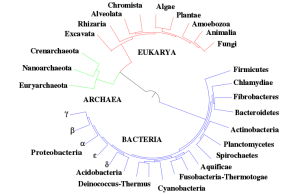
Evolution Step 1: Production and Redistribution of Variation
As we know, production and redistribution of variation is the first step of evolution. There are several factors involved in the production and redistribution of variation:
- Mutation
- Genetic drift
- Gene flow, and
- Recombination
These factors, along with natural selection, which is the second step of evolution, are frequently referred to as the forces or mechanisms of evolution.
Mutation
Mutation is a random change in the genetic coding and is the only new source of genetic material. Mutations occur during the DNA replication process. In an evolutionary sense, it is only mutations that occur during meiosis (replication of sex cells) that are hereditary. Many mutations do not have detrimental effects to the individual, but some do. If the mutations are extreme, pregnancy often results in spontaneous abortion (miscarriage). However, mutations provide a necessary pool of genetic variation in a population.
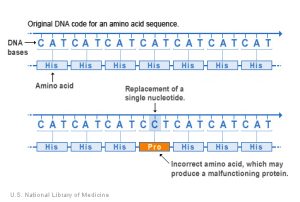
There are different types of mutations. The first is a point mutation, which is a small change in the DNA sequence. Point mutations may be synonymous point mutations or silent mutations, which means that while the codon is altered the same amino acid is produced, or nonsynonymous point mutations, which result in the production of a different amino acid that can have a negative effect on the individual. For instance, sickle cell anemia results in a point mutation where “…a mutation on human chromosome 11 converts a GAG codon into a GTG codon. The GAG codon is encoded to produce the amino acid valine, whereas the GTG codon is encoded to produce glutamic acid. This substitution results in sickle cell anemia…” (Larsen 2008: 93).
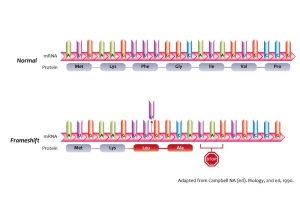
Frameshift mutations occur when one or more nitrogenous bases are inserted into or deleted from the DNA sequence. The insertion or deletion causes the reading of the gene to be altered or stopped. It results in the production of a nonfunctioning protein.
Transposable elements are mutations that occur when pieces of DNA copy themselves into new areas of chromosomes. If this occurs in a non-coding segment of the DNA then there are little to no effects on the individual. If it transposes to a coding segment of DNA then serious consequences can occur. In extreme cases, entire chromosomes may be copied (a trisomy) or deleted (a monosomy).
Mutations may have no known cause. These are called spontaneous mutations. Mutations caused by environmental factors are called induced mutations.
Genetic Drift

Genetic drift is the “…chance variation in allele frequency in small populations” (Gould 2006:1036). This can happen in a couple of ways: founder effect and bottleneck effect (or population bottleneck). Founder effect can occur if a small group separates from its parent group and settles elsewhere. Geographic isolation and endogamous marriage (a human marriage pattern where mates are chosen from within a specific group, narrowing the gene pool) or mating practices restrict the gene pool, resulting in a lack of variation in comparison to the original parent population. If an allele is rare in the parent population, the small breeding population of the new group creates an environment whereby the rare allele can become common.
There are numerous examples of the founder effect among human populations. These include,
- Huntington’s Disease in Afrikaner populations in South Africa and among Venezuelans living near Lake Maracaibo,
- Prevalence of O blood type in Native Americans
- Ellis-van-Creveld syndrome (polydactyly) in Amish communities, and
- The Blue People of Kentucky (learn more about the Blue People)

Bottleneck effect occurs when a population is drastically reduced in size due to some disaster, e.g., natural disaster, habitat destruction, or disease, leaving the surviving population with different allele frequencies from the original population. Four human population bottlenecks all related to climatic events have been identified. The most severe occurred about 70,000 years ago when a supervolcano erupted in Sumatra. It is estimated that only 5000 females survived in Africa (Ambrose 2003).
Gene Flow

Gene flow, also called admixture or migration (in reference to people), is the “movement of genetic material within and between populations” (Welsch et.al. 2017: 72). For humans, gene flow generally occurs when people move from one location to another; however, in the modern world it is not out of the realm of possibility that someone’s genetic material could move without the actual human being leaving their hometown. It should also be noted that migration does not always result in gene flow. For gene flow to occur interbreeding must happen. Human populations have exchanged genetic materials for millennia, helping to explain why there is only one human species.
Gene flow effects evolution in a couple of important ways (Evolution 101, 2015):
- With the introduction and reintroduction of genes to a population its genetic variation is increased, and,
- The movement of genetic material can make distant populations genetically similar to one another, which reduces the chance of speciation.
Recombination
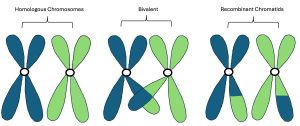
Recombination, or crossing over, can occur during meiosis. As the term implies, segments of chromosomes are exchanged between non-sister chromatids. This creates new combinations of genes that are not found in either parent (Speer 2003).
Evolution Step 2: Natural Selection

Types of selection
Once variation is produced in some combination of the above processes, natural selection goes to work, causing directional change in allele frequency related to environmental conditions that may result in evolutionary change, i.e., speciation. Shifts in allele frequency are called adaptation. In phrasing it this way, it sounds like natural selection works consciously, but it does not. Natural selection is a process that is mindless and mechanistic. Perfection and progress are not goals. It can only act on those variants that are present in a population.
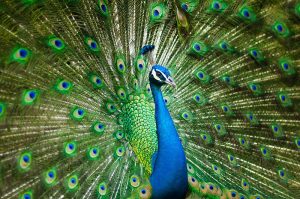
Darwin concluded, “…individuals with advantageous characteristics…survive in higher numbers and produce more offspring than members of a population lacking advantageous characteristics” (Larsen 2008: 96). This is referred to as differential reproduction or fitness. Specifically, fitness is defined by genotypes—some genotypes confer an advantage to an individual allowing that individual to reproduce at a greater frequency than another individual, characteristics that are inherited by their offspring. It could be something like beak shape that allows a bird to exploit resources better than other birds (think Darwin’s mockingbirds) or the color of wings that either hide or expose the peppered moth to predators (watch the Peppered Moth for the full explanation) or a coloring, like the plumage of a male peacock, that attracts mates (this is referred to as sexual selection, which is a special case of natural selection which refers to an individual’s ability to attract and copulate with a mate), leading to differential reproduction.

There are three types of selection: disruptive, stabilizing, and directional selection. With disruptive selection, both homozygotes (the phenotypic extremes) are selected for while with directional selection only one of the homozygotes is selected for. Disrupting selection may result in a speciation event. Stabilizing selection refers to selection for the heterozygote, resulting in decreasing genetic diversity within the population.
If you would like a bit more on the types of selection, check out Bio.edu: Stabilizing selection Disruptive selection Directional selection
Species and Speciation
Mayr (1942; quoted in Provine 2004) proposed the most commonly referenced definition of species, “Species are a group of actually or potentially interbreeding natural populations, which are reproductively isolated from other such groups.” This definition is often referred to as the biological species concept. A key factor is that a species actually or potentially breeds in nature. However, this definition can be difficult to apply; e.g., organisms that reproduce asexually or organisms that form hybrids (carrion crows and hooded crows sometimes interbreed—are they one species or two species?).
The biological species concept falls apart when applied to the fossil record, as it is impossible for scientists to observe the breeding behaviors of extinct organisms. Because of this, fossil species are called paleospecies and can cover long periods of time. Paleontologists and paleoanthropologists use comparative analysis with contemporary species that are closely related to determine whether variation seen in fossil specimens is intraspecific (differences within a species due to age and sex) or interspecific (differences due to reproductive isolation). It is important to remember that the species or paleospecies name is a classificatory tool used in the sciences. It helps scientists organize information and communicate more easily with one another.
Speciation is “…the process by which a new species evolves from an earlier species (Jurmain et al 2013: 105). This idea is one of Darwin’s five theories, specifically those of common descent and multiplicity of species, whereby new species arise from earlier species.

Test Yourself
Can you answer the following questions? If not, reread the chapter.
- What is the modern synthesis?
- What is the definition of evolution according to the modern synthesis?
- What is the process of evolution?
- How is variation produced?
- What is natural selection? How does it work?
- What is the biological species concept? What are its problems?
References
Ambrose S. 2003. Population bottleneck. In: Genetics, Vol. 3. New York (NY): Macmillan Reference USA. p. 167-171.
Artmann S. 2006. Neo-Darwinism, Origin of. In: Encyclopedia of anthropology, Vol. 4. Thousand Oaks (CA): SAGE Reference. p. 1727-1732.
Dusheck J. 2003. Population genetics. In: Genetics, Vol. 3. New York (NY): Macmillan Reference, USA. p. 171-174.
Ernst Mayr and the evolutionary synthesis. c2001. Boston (MA): WGBH Educational Foundation and Clear Blue Sky Productions; [accessed 2015 May 12]. http://www.pbs.org/wgbh/evolution/library/06/2/l_062_01.html.
Evol3000. 2013. Athens (GA): Department of Genetics, University of Georgia; [accessed 2015 May 12]. http://wallace.genetics.uga.edu/groups/evol3000/wiki/fb221/Bottlenecks_and_Founder_Effects.html.
Evolution 101. c2015. Berkeley (CA): University of California Museum of Paleontology; [accessed 2015 May 12]. http://evolution.berkeley.edu/evolibrary/article/evo_01.
Ferrell K. 2000. The modern synthesis of evolutionary theory. In: Science and its times, Vol. 6: 1900 to 1949. Detroit (MI): Gale. p. 104-107.
Gould JL. 2006. Genetic drift. In: Encyclopedia of anthropology, Vol. 3. Thousand Oaks (CA): SAGE Reference. p. 1036.
Heddle J. 2003. Mutation. In: Genetics, Vol. 3. New York (NY): Macmillan Reference USA. p. 93-98.
Jurmain R, Kilgore L, Trevathan W. 2013. Essentials of physical anthropology, 4th edition. Belmont (CA): Wadsworth, Cengage Learning.
Larsen CS. 2008. Our origins: discovering physical anthropology. New York (NY): W.W Norton & Company, Inc.
Larsen CS. 2022. Essentials of biological anthropology, 5th edition. New York (NY): W. W. Norton & Company.
Mayr, E. 1942. Systematics and the origin of species. New York (NY): Columbia University Press. Quoted in Provine, WB. 2004. Ernst Mayr: genetics and speciation. Genetics 167(3): 1041-1046.
Speer, MC. 2003. Crossing over. In: Robinson R, editor. Genetics, Vol. 3. New York (NY): Macmillan Reference USA. p. 194-197.
Sykora, P. 2006. Darwinism, modern. In: Encyclopedia of anthropology, Vol. 2. Thousand Oaks (CA): SAGE Reference. p. 692-696.
Welsch RL, Vivanco LA, Fuentes A. 2017. Anthropology: asking questions about human origins. New York (NY): Oxford University Press.
Cite this page.
APA Style: Saneda, T. M. 2022. The modern synthesis. In T. M. Saneda & M. Field, Biological Anthropology: a brief introduction. Cascadia College Pressbooks.
Chicago Style: Saneda, Tori M. 2022. “The Modern Synthesis.” In Biological Anthropology: A Brief Introduction, 3rd. Bothell, WA: Cascadia College Pressbooks.
CSE Style: Saneda TM. 2010. The modern synthesis. In: Biological Anthropology: a brief introduction, 3rd ed. Bothell (WA): Cascadia College Pressbooks. [modified 2022; accessed 2022 Dec 5]. https://openwa.pressbooks.pub/anth205bioanth/chapter/modernsynthesis/.

